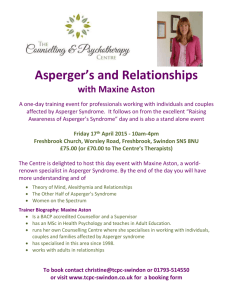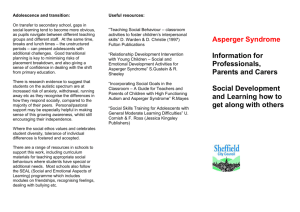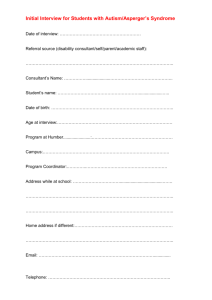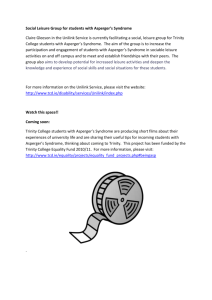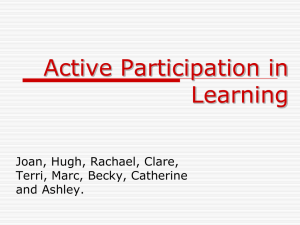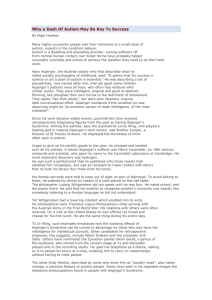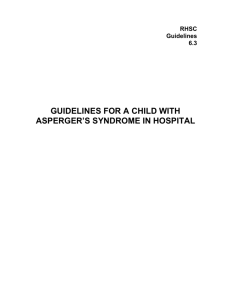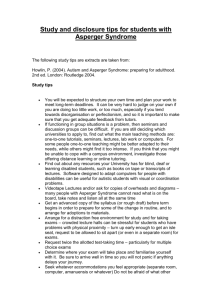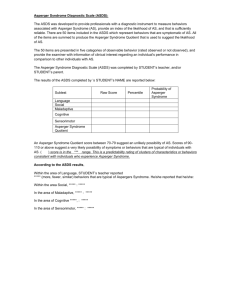CHILDREN WITH ASPERGERS SYNDROME
advertisement
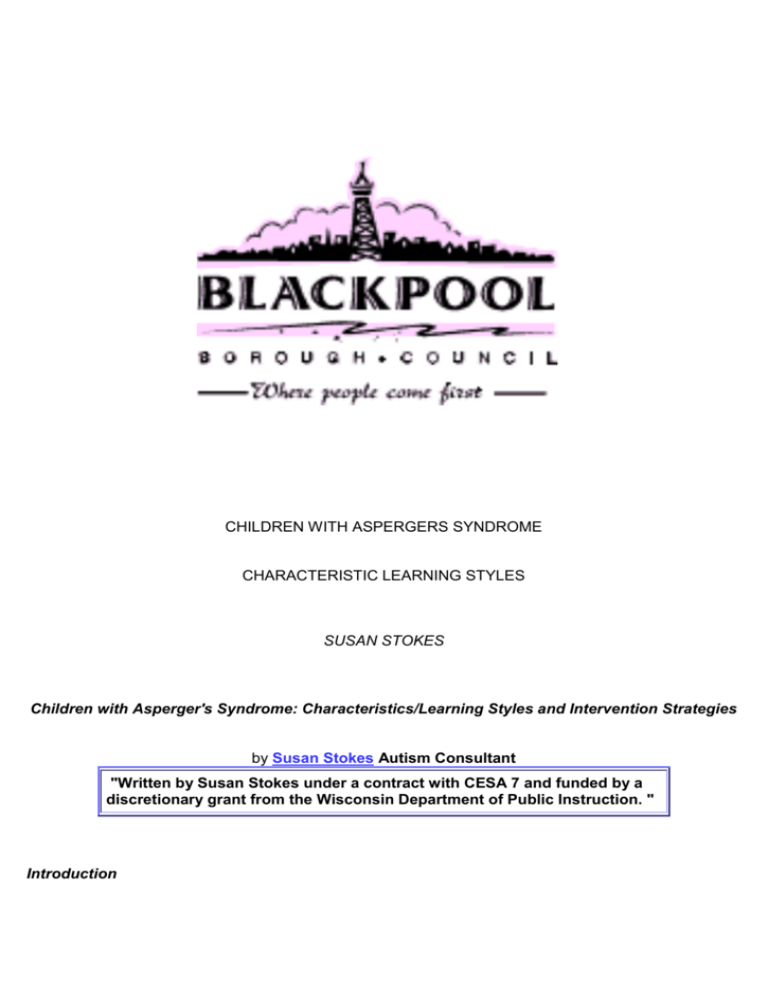
CHILDREN WITH ASPERGERS SYNDROME CHARACTERISTIC LEARNING STYLES SUSAN STOKES Children with Asperger's Syndrome: Characteristics/Learning Styles and Intervention Strategies by Susan Stokes Autism Consultant "Written by Susan Stokes under a contract with CESA 7 and funded by a discretionary grant from the Wisconsin Department of Public Instruction. " Introduction Asperger's Syndrome was named for a Viennese psychiatrist, Hans Asperger. In 1944 Asperger published a paper in German describing a consistent pattern of abilities and behaviors that occurred primarily in boys. In the early 1980s Asperger's paper was translated into English, which resulted in international recognition for his work in this area (6). In the 1990s, specific diagnostic criteria for Asperger's Syndrome were included in the American Psychiatric Association's Diagnostic and Statistical Manual of Mental Disorders, 4th Edition (DSM-IV, 1994) as well as the International Classification of Diseases, 10th edition (ICD10) (3) & (15). In general, DSM-IV and ICD10 base their diagnostic criteria for Asperger's Syndrome on the following: Impairment of social interaction Impairment of social communication Impairment of social imagination, flexible thinking and imaginative play Absence of a significant delay in cognitive development Absence of general delay in language development (in Wisconsin, the child may still have an impairment under the state eligibility criteria for speech & language) Recent research establishes the prevalence of Asperger's Syndrome as approximately 1 in 300, affecting boys to girls with a ratio of 10:1 (6). Children with clinical (medical) diagnosis of Asperger's Syndrome and who have been identified by schools as "children with disability" are typically found by the IEP Team conducting the evaluation to have an impairment in such areas as Autism, Speech/Language, or Other Health Impaired. Depending on the unique characteristics of the child, other impairment area listed under state law for special education may also be considered and used. This link will connect to the Wisconsin Department of Public Instruction for additional information on these areas: http://www.dpi.state.wi.us/dpi/dlsea/een/program.html. The general features and characteristics exhibited by children diagnosed with Asperger's Syndrome are similar to the general features and characteristics exhibited by children who have been clinically diagnosed with Autism and are described as having "high functioning autism". For educational purposes, the remainder of this paper focuses on the child with Asperger's Syndrome who has been identified by the IEP Team as being a child with a disability. Much of the following information is also relevant for consideration in working with children identified as having autism and who are described as having "high functioning autism". Training Each person who comes in contact with a child diagnosed with Asperger's Syndrome (either school staff or peers) should receive training on the unique characteristics and educational needs of such children. Due to confidentiality issues this should always be discussed first with the parents of the child with Asperger's Syndrome. Their written consent should be obtained prior to providing peer training. Educational Staff Training should include the following two components: o o General training of the entire school staff: Prior to working with children with Asperger's Syndrome, it is critical to understand the unique features and characteristics associated with this developmental disability. Staff should be informed that children with Asperger's Syndrome have a developmental disability, which causes them to respond and behave in a way which is different from other students. Most importantly, the responses/behaviors exhibited by these children should not be misinterpreted as purposeful and manipulative behaviors (4). o Child specific training for educational staff who will be working directly with the child: Educational staff who will be working directly with a child with Asperger's Syndrome should understand his individual strengths and needs prior to actually working with the child. A team of persons familiar with the child and his disability should provide this training. The team may include previous teacher(s), speech/language pathologist, occupational therapist, teacher aide and most importantly, the child's parents. Peer training: The peers/classmates of the child with Asperger's Syndrome should be told about the unique learning and behavioral mannerisms associated with Asperger's Syndrome. It is important to note that parent permission must always be given prior to such peers' training. A successful protocol for training peers at the kindergarten to approximately second grade level was developed by Division TEACCH and is available at their web site http://www.unc.edu/depts/teacch/. Another peer training protocol designed for children between the ages of 8-18 is Carol Gray's "Sixth Sense" (10). Characteristics and Learning Styles: General The following characteristics and learning styles associated with Asperger's Syndrome are important to consider, particularly their impact on learning, and in planning an appropriate educational program for the child (7). Children with Asperger's Syndrome exhibit difficulty in appropriately processing in-coming information. Their brain's ability to take in, store, and use information is significantly different than neurotypically developing children. This results in a somewhat unusual perspective of the world (7). Therefore teaching strategies for children with Asperger's Syndrome will be different than strategies used for neuro-typically developing children. Children with Asperger's Syndrome typically exhibit strengths in their visual processing skills, with significant weaknesses in their ability to process information auditorilly. Therefore use of visual methods of teaching, as well as visual support strategies, should always be incorporated to help the child with Asperger's Syndrome better understand his environment. The remainder of this article describes ten primary characteristics of children with Asperger's Syndrome and intervention strategies for each. Social Relation Difficulties Characteristics: Children with Asperger's Syndrome tend to exhibit a lack of effectiveness in social interactions rather than a lack of social interactions. They tend to have difficulty knowing how to 'make connections' socially (4). Social situations are easily misread by children with Asperger's Syndrome and as a result, their interactions and responses are often interpreted by others as being odd (4). Children with Asperger's Syndrome can exhibit low self-esteem and possible depression, particularly when they reach adolescence, due to their painful awareness of the social differences that exist between them and their peers (12). They have a desire to "fit in" socially, yet have no idea how to do this. Children with Asperger's syndrome can be significantly impacted by the following characteristics of social relations: Social Reciprocity: Children with Asperger's Syndrome can exhibit an imbalance in reciprocal social relations (i.e., the "give and take" in social relationships), which can be exhibited in several ways: o The child can exhibit the need to take control and direct social situations according to his own limited social rules and social understanding. Although the child may be able to initiate interactions with others, these interactions are typically considered to be "on his own terms". These interactions appear to be very egocentric in that they relate primarily to the child's specific wants, needs, desires and interests and do not constitute a truly interactive, giveand-take social relation with another person. o The child can appear very quiet, withdrawn and even unresponsive. He exhibits limited social drive. It can be extremely difficult for the social participant to engage the child in a social relation. (e.g., A child with Asperger's Syndrome was having a birthday party at her home. When the other children arrived, she stayed in the living room with them for a short while. She then said, "good-night", and stayed in her room for the rest of the party.). Recognizing and interpreting various social situations: Typically developing children are able to recognize and interpret the social nuances of various social situations without being specifically taught. Their intact processing systems allow for this to occur. However children with Asperger's Syndrome typically have great difficulty recognizing, understanding and thus applying appropriate social skills to various social situations. Their unique processing/learning systems do not readily allow for accurate recognition and interpretation of this seemingly abstract information (14). Social rules: Children with Asperger's Syndrome typically do not learn social rules, either by observing others or through frequent verbal reminders. These children do not appear to be intentionally ignoring and/or breaking these rules. Instead, they have a difficult time accurately perceiving social environments and thus, they do not understand that a particular social rule is to be applied in a specific social context. Example: A teacher frequently reminds a child with Asperger's Syndrome, prior to going out for recess, that he cannot push other children. The child repeats this rule prior to going out to recess. However, when the child goes onto the playground at recess, he pushes several children. Friendship skills: Children with Asperger's Syndrome tend to exhibit limited knowledge of the concept of friendship. Example: When a teenager with Asperger's Syndrome was asked if he had any friends he responded that friendship was an area where he had some problems. He was able to name two peers whom he considered "friends"; however, he did not know the last name of one of the students. He proceeded to physically describe the student to see if the listener knew the student's last name. When asked why these students were his friends, he said because he saw them in the hallway during passing period, and that he also saw one of the students at a weekly church youth group meeting. When asked if he and his "friends" went to each others' houses, talked on the phone, etc., the teen with Asperger's Syndrome said no, that he just saw them at different places). Children with Asperger's Syndrome also do not appear to attend to or respond to peer pressure. They may have definite preferences for clothing due to comfort level, in relation to sensory sensitivities without regard or concern for popular styles as worn by peers. Example: Some children prefer no ridges on the collar, no buttons down the front of a shirt, no blue jeans - only elastic waist pants, no long/short sleeves or long/short pants, etc. Understanding and expressing varied emotional states: Children with Asperger's Syndrome may have difficulty identifying (labeling and understanding) varied emotional states, both in themselves and in others. In addition, regulation of emotional states can be extremely difficult. Example: When experiencing great distress, a child with Asperger's Syndrome continually asks others for monitoring of his emotional states, "Am I under control yet?", He has limited awareness of when he is calm, versus extremely upset. Another example would be laughing, seemingly inappropriately, when others are hurt, embarrassed, etc. One child with Asperger's Syndrome physically manipulates his face when requested to exhibit various emotional states. Social Relation--Intervention Strategies: The child with Asperger's will need to be directly taught various social skills (recognition, comprehension and application) in one-to-one and/or small group settings. Social skills training will also be needed to generalize previously learned social skills from highly structured supportive contexts to less structured settings and, eventually, real-life situations. It is important to emphasize that children with Asperger's Syndrome will not learn social relations by watching other people, or by participating in various social situations. They tend to have great difficulty even recognizing the essential information of a social situation, let alone processing / interpreting it appropriately. Tools for teaching social skills: The use of Social Stories (9) and social scripts can provide the child with visual information and strategies that will improve his understanding of various social situations. (See the previous article on "Assistive Technology" for an explanation on social stories.) In addition, the Social Stories/scripts can teach the child appropriate behaviors to exhibit when he is engaged in varied social situations. The repetitious "reading" of the Social Story/script makes this strategy effective for the child with Asperger's Syndrome. A 3-ring binder of Social Stories/scripts kept both at home and school, for the child to read at his leisure, has proven very successful for many students with Asperger's Syndrome "Social Stories" o Role-playing various social situations can be an effective tool for teaching a child appropriate social responses. o Video-taping/audio-taping both appropriate and inappropriate social behaviors can assist the child in learning to identify and respond appropriately to various social situations. o "Lunch/recess club" is a structured lunch/recess time with specific peers to focus on target social skills for the child with Asperger's Syndrome. This strategy can assist in generalizing social skills previously learned in a structured setting. o Comic Strip Conversations (8) can be used to visually clarify social interactions and emotional relations (see sample ComicStrip conversations photo). o Peer partners/buddies: Specific peer(s) can be chosen to accompany and possibly assist the child with Asperger's Syndrome during less structured social situations and when experiencing social difficulties (e.g., out of class transitions, recess, lunch, etc.). This peer support network should initially be established in a small group setting. o Individualized visual social "rule" cards can be taped to the child's desk as a visual reminder regarding appropriate social behaviors to exhibit. Portable "rule" cards can be used for environments other than the classroom. The rules can be written on index cards, laminated, and then given to the child to carry along as visual reminders of the social "rules" for any particular context. "Personal Rule" Card Social Communication Difficulties Characteristics: The child with Asperger's Syndrome typically exhibits highly articulate and verbose expressive language skills with large vocabularies, particularly regarding specific topics (high interest areas). However, his convincing language skills can easily be misinterpreted as advanced communication skills. In turn this can result in a mislabeling of the child's actions as purposeful or manipulative, rather than behavior that is due to the child's significant difficulty in understanding and using appropriate social communication skills. Children with Asperger's Syndrome often lack social communication skills to sustain even minimal social communicative interactions in any of the following areas: Conversational discourse skills: Children with Asperger's Syndrome can generally engage in routine social interactions such as greetings. However, they may exhibit significant difficulty engaging in extended interactions, or "two-way" relationships (12). They can have difficulty initiating and maintaining appropriate conversations, engaging in conversational turn-taking, and changing topics in an appropriate manner. Their language can be extremely egocentric in that they tend to talk at people, instead of to them, exhibiting seemingly one-sided conversations (2). Incessant question asking can also be prevalent, as well as difficulty in repairing conversational breakdowns. Understanding and using non-verbal social communication (discourse) skills: Children with Asperger's Syndrome can have significant difficulty interpreting non-verbal social communication skills used to regulate social interactions (e.g., tone of voice, facial expressions, body postures, gestures, personal space, vocal volume, use of eye contact to "read" faces, etc.). For example, they may not understand that a raised vocal volume can convey an emotional state such as anger (e.g., A student with Asperger's Syndrome stated, "Why are you talking louder? I can hear you" when his mother raised her voice to communicate anger). These children may also have difficulty interpreting non-verbal cues, which the listener might be giving to communicate that a conversational breakdown has occurred (e.g., facial expressions to indicate not understanding the message, boredom, etc.). Some children with Asperger's Syndrome can exhibit conversational speech with a somewhat flat affect: limited vocal change regarding vocal tone, volume, pitch, stress and rhythm, particularly to indicate emotion and/or emphasize key words. Narrative discourse skills: Children with Asperger's Syndrome can exhibit difficulty with their narrative discourse skills, including relating past events, or retelling movies, stories, and T.V. shows in a cohesive and sequential manner. They may leave out important pieces of relational information, as well as referents, and may use many revisions, pauses and/or repetitions. Example: A child with Asperger's Syndrome was relating his weekend to the class. The child with Asperger's Syndrome related: "Back through time, uhm, uhm, at my Grandma's, uh, it was (pause) back through time. I was, I was, I (pause) I uh, a long time ago. I was at my Grandma's." Social Communication - target skills and strategies for intervention: The following social communication skills (pragmatic language skills) may be focused on for direct instruction, depending upon the child's individualized needs: Initiation of appropriate social interactions for various situations through appropriate verbal utterances, rather than actions or behaviors (e.g., On the playground, the child with Asperger's Syndrome should use the words "Wanna play chase?" to ask a peer to play tag, rather than going up to the peer and shoving them); Topic initiation of varied topics - not only topics related to high interest areas; Topic maintenance, particularly for topics initiated by others. Conversational turn-taking across 3-4 turns (reciprocal communication skills); Asking questions of others related to topics initiated by others; Calling attention to communicative utterances. The child directs his communication to someone by first calling the other person's attention to himself; Comprehension and use of nonverbal social communication skills: tone of voice, personal space, vocal volume, body orientation, facial expressions, etc.; Narrative discourse skills: relating past events, retelling stories sequentially and cohesively by including important pieces of relational information as well as referents; Greetings; Seeking assistance appropriately (e.g., raising his hand for help in the classroom). "Greeting Card" Tools for teaching social communication skills: All of the tools listed previously for teaching social skills can also be used to teach social communication skills, with the addition of the following: Visual support strategies can be used to teach conversational discourse skills such as turn-taking, topic initiation, topic maintenance, etc. For example, a visual "my turn" card can be used to physically pass back and forth between conversational partners, to visually indicate who's turn it is in the conversation.
